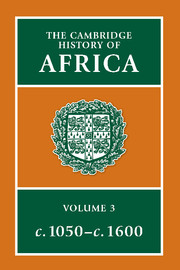Book contents
- Frontmatter
- Introduction: some interregional themes
- 1 Egypt, Nubia and the Eastern Deserts
- 2 Ethiopia, the Red Sea and the Horn
- 3 The East Coast, Madagascar and the Indian Ocean
- 4 The eastern Maghrib and the central Sudan
- 5 The western Maghrib and Sudan
- 6 Upper and Lower Guinea
- 7 Central Africa from Cameroun to the Zambezi
- 8 Southern Africa
- 9 The East African interior
- Bibliographical Essays
- Bibliography
- Index
- References
2 - Ethiopia, the Red Sea and the Horn
Published online by Cambridge University Press: 28 March 2008
- Frontmatter
- Introduction: some interregional themes
- 1 Egypt, Nubia and the Eastern Deserts
- 2 Ethiopia, the Red Sea and the Horn
- 3 The East Coast, Madagascar and the Indian Ocean
- 4 The eastern Maghrib and the central Sudan
- 5 The western Maghrib and Sudan
- 6 Upper and Lower Guinea
- 7 Central Africa from Cameroun to the Zambezi
- 8 Southern Africa
- 9 The East African interior
- Bibliographical Essays
- Bibliography
- Index
- References
Summary
The second half of the ninth century seems to have been a period of revival for the Christian kingdom of Ethiopia. The damage done to its economic life by the rapid expansion of Islamic power in the Near and the Middle East had not destroyed Aksum altogether. It had only weakened it. Unable to maintain its usually strong frontier garrisons, Aksum had lost extensive territories on the Red Sea coast as well as along the Beja borderlands in the north. Furthermore, the areas which had long been conquered and incorporated into the empire beyond the Tekeze river in the west – notably the Walqayt and probably also the ancient Samanoi – had apparently broken off and regained their independence. These calamities had befallen the Christian empire of Aksum in rather rapid succession, following upon the rise of Islam and the eventual control of the Red Sea trade by Muslim powers and merchants. All this seems to have brought about a certain degree of political disintegration and a decisive weakening of the central institutions of the state for a period of over two centuries. But when, in the last quarter of the ninth century, we begin to have a few literary and traditional references to the Ethiopian region, it becomes very clear that the Christian state had definitely survived all these vicissitudes in the highland areas of southern Eritrea, Tigre, Lasta and Angot. These areas form the high ridge which separates the basins of the numerous rivers flowing in the direction of the Nile and the Red Sea, and as such they constitute a compact geographical unit.
- Type
- Chapter
- Information
- The Cambridge History of Africa , pp. 98 - 182Publisher: Cambridge University PressPrint publication year: 1977
References
- 4
- Cited by

